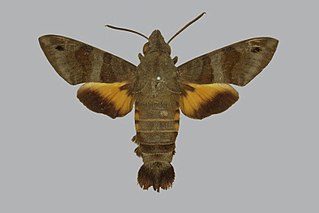Related Research Articles

Hypena is a genus of moths in the family Erebidae. It was first described by Franz von Paula Schrank in 1802. These non-migratory moths overwinter as pupae and almost never come to bait as adults.
Correbidia is a genus of moths in the subfamily Arctiinae. The genus was erected by George Hampson in 1898.

Pennisetia hylaeiformis, the raspberry clearwing, is a moth of the family Sesiidae.

Polyptychoides assimilis is a moth of the family Sphingidae. It is found in South and East Africa, including Sudan. Some authors consider it to be a subspecies of Polyptychoides grayii.
Tarache is a genus of moths of the family Noctuidae erected by Jacob Hübner. It includes most former New World Acontia species. Lepidoptera and Some Other Life Forms and The Global Lepidoptera Names Index report this name as a synonym of Acontia.

Macroglossum assimilis is a moth of the family Sphingidae. It was described by William John Swainson in 1821 and is known from India and Sri Lanka.
Leucoptera loxaula is a moth in the family Lyonetiidae. It is known from South Africa and Zimbabwe.
Correbidia terminalis is a moth in the subfamily Arctiinae. It was described by Francis Walker in 1856. It is found from Mexico through Central America and Cuba and Puerto Rico to South America.
Eupithecia assimilis is a moth in the family Geometridae. It is found in French Guiana and Brazil.
Correbidia calopteridia is a moth of the subfamily Arctiinae. It was described by Arthur Gardiner Butler in 1878. It is found in Pará, Brazil.
Correbidia notata is a moth of the subfamily Arctiinae. It was described by Arthur Gardiner Butler in 1878. It is found in the Amazon region.
Correbidia striata is a moth of the subfamily Arctiinae. It was described by Herbert Druce in 1884. It is found in Panama.
Correbidia costinotata is a moth of the subfamily Arctiinae. It was described by Schaus in 1911. It is found in Costa Rica.
Correbidia joinvillea is a moth of the subfamily Arctiinae. It was described by Schaus in 1921. It is found in Brazil.
Correbidia simonsi is a moth of the subfamily Arctiinae. It was described by Rothschild in 1912.
Heliura assimilis is a moth of the subfamily Arctiinae. It was described by Rothschild in 1912. It is found in Peru.
The Euchromiina are a subtribe of tiger moths in the family Erebidae. It was described by Arthur Gardiner Butler in 1876. Many species in the subtribe are mimics of wasps.

Gryllus assimilis, commonly known as the Jamaican field cricket and sometimes referred to as the silent cricket among other names, is one of many cricket species known as a field cricket. Its natural habitats are the West Indies and parts of the southern United States, Mexico, and South America, though as a result of widespread breeding programs to supply feeder insects to the pet industry since 2010, it has become available commercially throughout North America and Europe.
Melanchra assimilis, known generally as the black arches or similar black noctuid, is a species of cutworm or dart moth in the family Noctuidae. It is found in North America.
Hypena assimilis, is a moth of the family Erebidae first described by George Hampson in 1891. It is found in India, Sri Lanka and Taiwan.
References
- ↑ Beccaloni, G.; Scoble, M.; Kitching, I.; Simonsen, T.; Robinson, G.; Pitkin, B.; Hine, A.; Lyal, C., eds. (2003). "Correbidia assimilis". The Global Lepidoptera Names Index . Natural History Museum . Retrieved May 1, 2018.
- ↑ Moths of Belize
| This Arctiinae-related article is a stub. You can help Wikipedia by expanding it. |